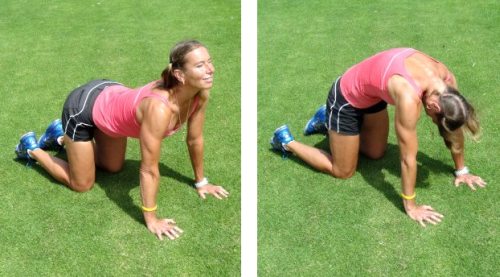Good stuff re: the walking.
My experience started when I played squash years ago. I saw the person who was then the Aussie Olympic doctor. He thought surgery was an option - although my issue was confined to L5 and L4 so not quite as extensive as you. We opted to try mild therapy and a few set exercises and, surprisingly, I got to a level I could live with relatively quickly. I've had flare-ups, especially when I spend a lot of time sitting at a desk or do something like kayaking but can get back to manageable levels within a short period.
One thing I most definitely do not agree with re: your trainer is the double leg lift. He is dead wrong and every time you do it you're probably making your back worse - fyi this is straight from the mouth of a Dr who treated many dozens of gold medal winning athletes.
There is simply no way - unless done with solid form - for it not to cause additional stresses on the lower back. Think about it - when you lift your legs all the pressure and weight of your legs gets focussed into the pivot point, which presses your hips into the floor as the load increases. To compensate for the weight as you raise/lower your legs your back will naturally arch (unless you have super light legs

). This massively increases the force on the bones in the lower back. Hence the one leg idea - you use the other leg to brace properly and reduce the weight by half. But, keeping the small of your back as flat on the floor as much as possible is
key.
I'm very surprised your PT hasn't explained this (or has he?). Without keeping your lumbar region as flat on the floor as you can manage this exercise is 100% pointless.
A note on this: start this exercise is with the leg skywards, not on the floor. It means you can focus on the flat back thing better and then lower your leg. Doing it from the floor up you start at the point of highest weight/pressure so will be harder to find good form initially.
Someone else posted some other exercises - cats & dog and the pic of the yoga exercises. I do a few of them daily and they seem to be good for easing annoying muscle tension and strengthening
without loading up the lower back as many normal core exercises do. That is what you're trying to achieve.
It's worth considering that the bottom of the spine has all of the weight of the body above it pushing down on it. Most of the pain (assuming it's not skeletal injury) will be down to chronically tight or inflamed muscles and connective tissue -
not lack of strength. So, on one hand you're trying to find a way to ease the load on the back by improving the torso muscles, but you also need to ease all the tight muscles/connective tissues around the spine/hips which are likely giving you the pain - not making them tighter by overworking them more, especially with poor form. When you have a sore back they're in an almost constant state of tension and mild probably inflammation too. If you find yourself at your desk holding your abs tight to alleviate your lower back pain then this is a good demonstration of it - even sitting or lying down they can be overworked.




